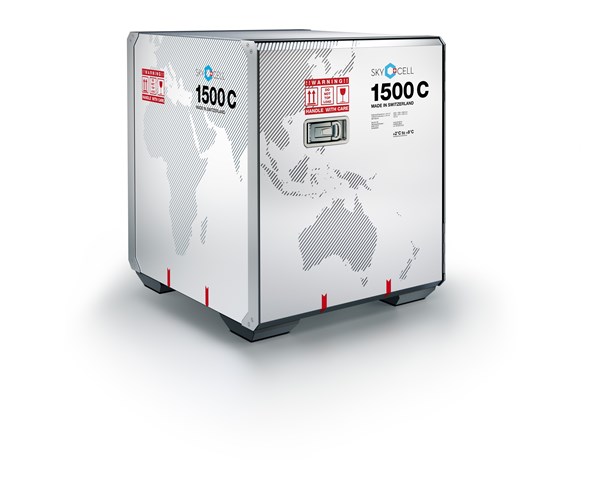Multi-material shipping container for pharmaceuticals
This past week, CW was made aware of a new, high-tech and multi-material unit load device (ULD) shipping container solution from an innovative container company called Smart Containers Group (Zurich, Switzerland).

Smart Containers Group’s SkyCell multi-material shipping container
Containerization, or massing smaller pieces of cargo together in a single, larger container, was first practiced for shipping of coal in 17th Century England. The idea has evolved since into the now-ubiquitous stackable intermodal containers seen on container ships, trains and trucks. Likewise, the commercial aircraft industry developed lighter-weight container versions called Unit Load Devices, or ULDs, to containerize cargo shipments on planes. Several efforts have been reported in CW of composites-intensive ULDs (for instance, here: https://www.compositesworld.com/news/tencate-advanced-armor-usa-will-fabricate-composite-cargo-containers-for-air-cargo-containers-providing-material-and-assembly-). This past week, CW was made aware of a new, high-tech and multi-material ULD solution from an innovative container company called Smart Containers Group (Zurich, Switzerland).
Smart Containers Group is working with the pharmaceutical industry, where safe, temperature-controlled shipping of sensitive goods is vital. Smart Containers Group CTO and co-founder Nico Ros spoke to me about what goes into this high-tech shipping box.
In shipping pharma products, he explains, it is vitally important that the temperature of the product be constant, and that fragile contents withstand the shocks of handling. The key attributes of the SkyCell container had to be, therefore, the ability to absorb double-digit G forces, and have a highly-efficient insulation layer, all while keeping overall weight less than competing metallic ULD boxes. “We combine composite materials with aluminum in such a way so that the container can withstand substantial force via damping, to protect fragile contents. We liken it to a coconut, which has a relatively soft fiber skin but a hard core inside,” says Ros. The group wanted a skin material with some give that would not dent, like existing all-aluminum ULDs. They chose commingled ABS plastic fiber/woven textile (similar to the CURV self-reinforced composite material from Propex, Chattanooga, TN, US), held in place with aluminum extrusions at the edges and corners. Ros says, “It’s like a stretched canvas for an oil painting — the frame is rigid, and the ‘canvas’ has some flexibility. It’s a stable, lightweight solution.”
The reinforced fabric is backed by a highly-engineered core, which originated during a European research project to find ways to recycle and reuse non-food grade PET (polyethylene terephthalate) discards. His group developed a patented process to co-extrude nano-treated recycled PET granulate between two aluminum coatings, stamped with a raised honeycomb pattern. The proprietary aluminum surfaces, which form the upper and lower skins of the core, have a thickness of ~20nm, and the total core thickness is approximately 0.1 mm thick. Explains Ros, “This ultra-thin core design gives us metal-like properties to reflect heat but also gives us plastic-like properties for lower temperature conductivity.” The core surrounds an inner aluminum box within which the pallet is placed. Ethylene propylene diene monomer (EPDM) synthetic rubber feet support the box; the EPDM was selected for its acid resistance. Total external ULD dimensions for the 1500C ULD are 153 cm long by 132 cm wide by 160 cm high, to meet aircraft cargo container size; the inside dimensions are consistent with US standard pallet size. Maximum load rating is 1000 kg. On-board cloud-connected IoT sensors, based on blockchain technology, allow continuous monitoring. The company says the combined elements of the container, composite and metallic, are protected by 96 patents.
According to Smart Containers Group, it is the fourth largest supplier of containers to the pharmaceutical industry, and 12 major pharma firms have already validated the container for their products. This is due to the container’s performance at maintaining desired low temperatures, termed the “cold chain,” with a very low failure rate of 0.1%, compared to the overall industry average failure rate of 6 to 8%, says Ros: “For our customers, the actual production cost is not the point, it’s the logistics cost that is low because of the high performance and low failure rate of the container. Plus, the industry pools containers and they are reused many times. It is a niche market, but it’s a demanding market, and it will allow us to springboard into other applications, including perishable food shipping.”
To learn more about Smart Containers Group and their philosophy, visit the web site (https://smartcontainers.ch/) and watch this video of CEO and co-founder Richard Ettl introducing the SkyCell container at the Crypto Finance Conference earlier this year:
Related Content
TU Munich develops cuboidal conformable tanks using carbon fiber composites for increased hydrogen storage
Flat tank enabling standard platform for BEV and FCEV uses thermoplastic and thermoset composites, overwrapped skeleton design in pursuit of 25% more H2 storage.
Read MorePlant tour: Joby Aviation, Marina, Calif., U.S.
As the advanced air mobility market begins to take shape, market leader Joby Aviation works to industrialize composites manufacturing for its first-generation, composites-intensive, all-electric air taxi.
Read MoreThe potential for thermoplastic composite nacelles
Collins Aerospace draws on global team, decades of experience to demonstrate large, curved AFP and welded structures for the next generation of aircraft.
Read MoreManufacturing the MFFD thermoplastic composite fuselage
Demonstrator’s upper, lower shells and assembly prove materials and new processes for lighter, cheaper and more sustainable high-rate future aircraft.
Read MoreRead Next
VIDEO: High-rate composites production for aerospace
Westlake Epoxy’s process on display at CAMX 2024 reduces cycle time from hours to just 15 minutes.
Read MoreModeling and characterization of crushable composite structures
How the predictive tool “CZone” is applied to simulate the axial crushing response of composites, providing valuable insights into their use for motorsport applications.
Read MorePlant tour: A&P, Cincinnati, OH
A&P has made a name for itself as a braider, but the depth and breadth of its technical aptitude comes into sharp focus with a peek behind usually closed doors.
Read More






















